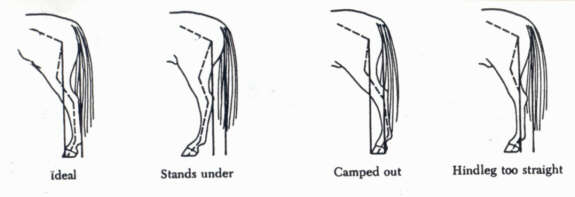
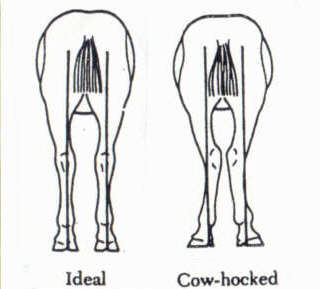
Problems involving hock and stifle soundness within our gaited horses seem to be on the increase. The 2002 season has brought 11 cases in horses all under the age of 8 years being unloaded from trailers for training here and one or both of theses issues were present.
Ten years ago, we were averaging 3 to 4 cases a year and in most cases it was more often stifle problems on Tennessee Walking Horses. I am experiencing hindquarter lameness issues in more clinic's than in past as well. We are now seeing both an increase of serious hock problems on virtually everybreed of gaited horse, be it a Rocky Mountain horse, Icelandic, Peruvian Paso, etc.
I have worked with many veterinarians over the years with diagnosis and treatments and myself own a horse with bone spavin in the right hind hock. Please, understand that I am not a veterinarian and am writing out of my own experience, which I have accumulated over many years with many horses. It is through the great work and help of many veterinarians that I express my opinions on this subject, and urge you to consult a veterinarian if you suspect a soundness issue in your horse.
It is very common for horses with behavior problems under saddle or that have gaiting issues to be thought of by the owners as a stubborn or unruly horse. When a horse starts to behave in this manner they are trying to communicate that something is wrong; they do not understand what we are asking, are being put under more pressure than they are ready for, or physical discomfort. It is we the owner and / or handles and riders that must step back and really take a look at what the horse is trying to say in the only way in which they can. In a physical evaluation sometimes it can be something as simple as a tooth problem, pinching bit or saddle fit but we need to also look deeper if changes do not come about after the simple details have been looked into.
Some Simple Signs of Trouble
It is not uncommon for stifle or hock problems to show some similar signs when trying to determine which joint is involved. It is my experience it is best to watch a horse from the side and from behind when lameness is suspected. A problem leg can be the one doing a shorter length stride, which can be seen but if you have a good ear can also be heard in the change of gait rhythm and timing. The whole hind limb can have a stiff way of moving and with high joint problems such as the stifle, hock or hips. This causes a lower arc of flight, resulting in some cases a dragging of the toe. This can be very slight or to the point that the toes catches causing a buckling of the hind limb. I would also like to note though that it is rather common to experience this buckling of a hind limb in many of our gaited horses. This can be due to lack of conditioning and strengthening or allowing a horse go stung out and not in the correct collection or contained frame for a desired gait. Allowing this buckling to happen to often in itself can cause over- extension and stress or damage to either joint, therefore it should be avoided if at all possible. When one sees a shortening of stride on one side it's time have a horse examined.
Watch in a horse that consistently lifts all the weight off of the same hind when stopped such as in a hip shod position.
Some will even take one step backward to bring the weight off the problem hind once stopped from forward motion. Note a horse that suddenly is not wanting to move forward as willingly. In some cases that horse will actually work out of a shorter strided way of going once they warm up, but this could be an early sign and one to be looked into rather than wait. When watching a horse from behind, in many cases when a lameness has gotten to a more serious stage a horse will lift the hip higher and let it drop lower than the un-effected leg. Sometimes a cracking sound coming from joints is a reason to be aware of a possible problem.
Know Your Horses Hindquarter Structure
A horses structure can predispose it to having the potential for hind limb lameness and we, as owners, need to look closely at our horse and know what limits we need to set in performance of an individual when their structure deviate from the ideal. Rarely is a horse absolultely perfect in the ideals that have been set in relation to structural elements. Some slight deviations may not be a reason for concern; but when any deviation expands to the point of a horse's ability to remain sound, then it should be taken as a much more serious matter. Also the best of structure can be mis-used to the point of causing lameness in any horse.


Possible Structural Elements to Hind Limb Lameness
A Hind leg too straight: Commonly known to be one prone to upward fixation of the patella, it can lock and become a chronic problem. The lack of proper angulation in the leg can also create too much concussion straight down through the hock.
Stands under (sickle hock): This type of structure is known to be one creating possible hock issues such as arthritis and / or spivins due to the strain placed on the back of the hock.
Camped out: Has the potential for hock problems again as in arthritis and spivins. It is important to note that when a horse that is camped out it can not support its weight correctly and create a problem for correct balance of the hindquarters.
Cow hocked: Cow-hocked type of structure creates undue strain on the inside of the hocks and stifle. Notice the arc from the stifle to the hoof. It is also common to see a twisting of the hocks which has a wrenching effect to the hips joint, stifles and hocks.
All these structural deviations should be ones we are aware of in limited use such as fast hard stopping or sliding stops and fast turns such as spins and roll backs. Overuse in jumping can also lead to problems with these types of structures.
Stifles, What Could Go Wrong
The stifle joint corresponds anatomically to our own human knee joint. It is the largest joint in the horse but also the weakest joint. It is a joint that has the ability to flex, extend and act as a locking mechanism. A horse is unable to flex the hock without flexing the stifle and hip joints.
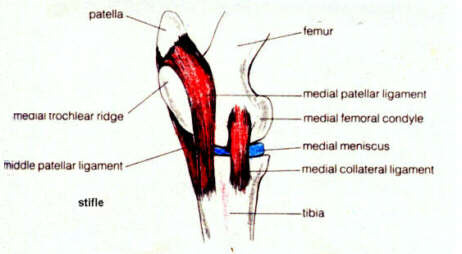
Upward fixation of the Patella: Also referred to as an uncontrollable locking of the stifle. The hind limb is locked in extention and the hock can not be flexed. This can start intermittently during forward motion. This can also progress to the point of the joint being stuck and a horse hopping on 3 legs. In some cases backing or a jump forward can release the sticking of the joint. The legs can move somewhat uncoordinated and jerky in their movement. One or both stifles can be affected. In palpation when the stifle is in a fixated state one can feel the ligaments being tense and ridged.
Causes are commonly related to poor structure but in the gaited horse
community it is being seen rather often due to weak or immature stifle
on horses being started for riding purposes at a young age. In a mature
horse often this weakness is due to lack of condition and strengthening.
In other cases, it is a matter of asking a horse to do to much under saddle
than it is built for or holding gaits longer than they were intended to
do. Other factors can be a horse just carrying to much weight for its structure
or an unbalanced rider for long periods of time.
It is my own observation that horses that have been allowed to pace
consistently tend to be suspeable to this, due to the strain of over extension
created by a hard swinging pace. It is common practice among some to hard
pace a horse to create a large desired overstride for a stepping pace but
in many cases a horse is not built to do this much overstride and in some
cases the stifles will bear the brunt of this kind of work. Long toes with
low heels is another cause being seen adding to strained stifle issues.
Treatment options
In all cases if a problem is suspected, I advice a vet exam immediately. A flexion test will be the first test done for diagnosis. Don't wait; what you do early could save much money and pain and continued sound use for the horse later. Depending on the diagnosis it may just be a matter of rest and then some slow type strengthening exercises. In some cases there are a variety of injection possibilities as options, and in extreme cases a vet may advise surgery. Regardless of the situation, it is my advise to go slow when starting under saddle again. Don't just get on a horse and start off gaiting. Warm them up and let the muscles stretch. Do not take a horse on a ride in which it has not had the proper amount of conditioning done. When strengthening a weak stifle I avoid tight circles; no hard turns, and make large, wide ones, I do lots of straight line work at a walk at first, and no hard and fast stopping. Plan your strengthening program well; stay with it. Know, too, if a horse stands again for a while, at some point you may have to restart the conditioning process over again.
I also advise when purchasing any horse get a vet check, flexion tests. Have the Stifle palpated to know if they have been previously cut. This is a common practice in some show barns or is done when a horse has had problems, and it is not uncommon for this not to be brought to a potential buyers attention. A horse that has had stifle surgery does have limitations as it no long has the normal support of that joint.
A look at potential Hock Problems
The hock joint actually consists of several joints; the top joint being the largest and where most of the flexion occurs, the lower three joint have the least amount of movement. Again, at any time a problem in this area is suspected, do not wait, get a veterinarian exam immediately. If the lameness can be isolated to the hock area through a flexion test, get x-rays done to first be aware if it is a case of a hard tissue problem and / or soft tissue to get the correct treatment. The term spavin in itself can entail soft or hard tissue in some cases creating enlargement or lump on the front of the hock. In some cases it involves cartilage deterioration, and arthritis without new bone growth creating fusion of the joint.
Bone Spavin: In some cases only one hock may only be involved, but is often bilateral. Hind limb stiffness is commonly seen with this, and in early stages will seem to warm up out of the stiffness. It is not uncommon for a horse to develop back soreness along with a hock problem. Dragging of the toes can be seen with lack of flexibility. It is not uncommon for a horse that normally is fine with having it's hooves trimmed to start showing some discomfort or unwillingness to stand as normally as in the past. Some horses will develop a swelling on the front of the hock; abnormal wear on the shoes can be an indicator. Some times with the onset x-ray will not show changes in the joints but with progression they will. As it progresses the joint spaces will become narrower. The joint will try to heal itself by producing new bone to bridge the joints. In some case once this fusing has finished a horse can move rather normally but in others the new growth to fuse can become rather ridged and pointing causing discomfort.
Blind Spavin (Occult Spavin)
The lameness of Blind spavin is very much like that of bone spavin.
X-rays will be needed to distinguish weather it is a bone spavin or blind
spavin. Blind spavin may not show any bone like changes in the hock
but nerve blocks are helpful to determine if it is isolated to the hock
area and is a blind spavin. There are many injection options available
now for temporary to long term relief and a vet can advises which ones
would be the best for each individual situation.
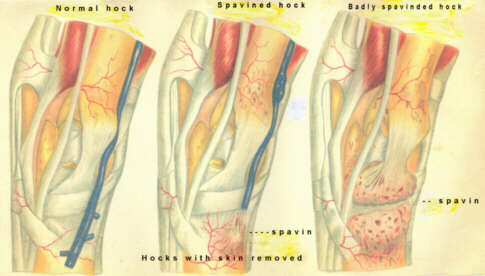
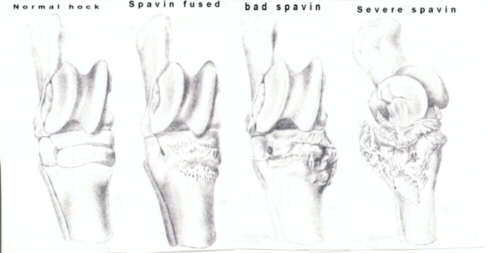
Any hock problems need to be taken very seriously and need to be addressed at the first signs. This is another situation where we are seeing an increased incidence because horses are being started to early to meet market and / or demands along with horses being used incorrectly, and hock issues are a growing problem.
What Can be Done for Possible Prevention of Soundness Issues
There are many simple things we can do to prevent theses from occurring.
The use of shoes with trailer on the hind's change the
natural travel of the hind leg. This in time can cause lots of stress and
strain to the hind limbs. A well structured horse's hoof will travel in
line with each other not to the outside of the front, which shoes with
trailers are used for in many gaited horse to avoid hitting the front hooves.
The forcing a horse to move in this toed out manner will cause twisting
of the hocks.

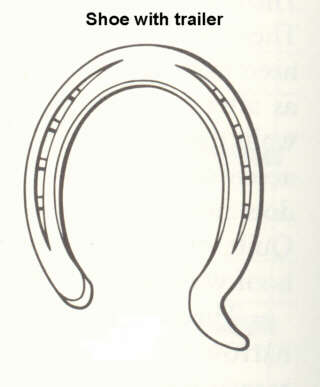
Closing Statements
I hope I have in this article shed some light on some of the hock and
stifle problems and some of the possible reasons they have become more
prevalent in many gaited breeds. Many of them could or can be prevented
be it through good breeding practices and not accetiping extremes in structural
deviations that we are now seeing just to get more out of a horse. The
horse is the one that pays the ultimate price for our decisions in breeding
matters.
Make better and more thought out decisions in training and riding our
horse's weather for show or trail use. Horse are now bringing higher prices
across the board than has ever been seen before and more so in our gaited
breeds. In some case, it has caused horses to be produced for quantity
not quality and quality mean's a longer more useful life for the
horse. They under no circumstances should be thought of as a disposable
item in my opinion.
NOTE: Please feel free to share this page.
Feed back is welcome at Marshal@sherbtel.net